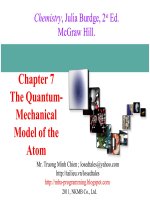chapter 7 the cost of production
Bạn đang xem bản rút gọn của tài liệu. Xem và tải ngay bản đầy đủ của tài liệu tại đây (309.23 KB, 55 trang )
Chapter 7
The Cost of
Production
Chapter 7 Slide 2
Topics to be Discussed
Measuring Cost: Which Costs Matter?
Cost in the Short Run
Cost in the Long Run
Long-Run Versus Short-Run Cost
Curves
Production with Two Outputs
Economies of Scope
Chapter 7 Slide 3
Introduction
The production technology measures
the relationship between input and
output.
Given the production technology,
managers must choose how to
produce.
Chapter 7 Slide 4
Introduction
To determine the optimal level of
output and the input combinations, we
must convert from the unit
measurements of the production
technology to dollar measurements or
costs.
Chapter 7 Slide 5
Measuring Cost:
Which Costs Matter?
Accounting Cost
Actual expenses plus depreciation
charges for capital equipment
Economic Cost
Cost to a firm of utilizing economic
resources in production, including
opportunity cost
Economic Cost vs. Accounting Cost
Economic Cost vs. Accounting Cost
Chapter 7 Slide 6
Opportunity cost.
Cost associated with opportunities that
are foregone when a firm’s resources
are not put to their highest-value use.
Measuring Cost:
Which Costs Matter?
Chapter 7 Slide 7
An Example
A firm owns its own building and pays no
rent for office space
Does this mean the cost of office space
is zero?
Measuring Cost:
Which Costs Matter?
Chapter 7 Slide 8
Total output is a function of variable
inputs and fixed inputs.
Therefore, the total cost of production
equals the fixed cost (the cost of the
fixed inputs) plus the variable cost
(the cost of the variable inputs), or…
VC FC TC
+=
Measuring Cost:
Which Costs Matter?
Fixed and Variable Costs
Fixed and Variable Costs
Chapter 7 Slide 9
Fixed Cost
Does not vary with the level of output
Variable Cost
Cost that varies as output varies
Measuring Cost:
Which Costs Matter?
Fixed and Variable Costs
Fixed and Variable Costs
Chapter 7 Slide
10
Fixed Cost
Cost paid by a firm that is in business
regardless of the level of output
Sunk Cost
Cost that have been incurred and cannot
be recovered
Measuring Cost:
Which Costs Matter?
Chapter 7 Slide
11
Cost in the Short Run
Marginal Cost (MC) is the cost of
expanding output by one unit. Since
fixed cost have no impact on marginal
cost, it can be written as:
Q
TC
Q
VC
MC
∆
∆
=
∆
∆
=
Chapter 7 Slide
12
Cost in the Short Run
Average Total Cost (ATC) is the cost
per unit of output, or average fixed
cost (AFC) plus average variable cost
(AVC). This can be written:
Q
TVC
Q
TFC
ATC
+=
Chapter 7 Slide
13
Cost in the Short Run
Average Total Cost (ATC) is the cost
per unit of output, or average fixed
cost (AFC) plus average variable cost
(AVC). This can be written:
Q
TC
or AVC AFC ATC
+=
Chapter 7 Slide
14
Cost in the Short Run
The Determinants of Short-Run Cost
The relationship between the production
function and cost can be exemplified by
either increasing returns and cost or
decreasing returns and cost.
Chapter 7 Slide
15
Cost in the Short Run
The Determinants of Short-Run Cost
Increasing returns and cost
With increasing returns, output is increasing
relative to input and variable cost and total
cost will fall relative to output.
Decreasing returns and cost
With decreasing returns, output is
decreasing relative to input and variable cost
and total cost will rise relative to output.
Chapter 7 Slide
16
Cost in the Short Run
For Example: Assume the wage rate
(w) is fixed relative to the number of
workers hired. Then:
Q
VC
MC
∆
∆
=
L VC w
=
Chapter 7 Slide
17
Cost in the Short Run
Continuing:
L VC
∆=∆
w
Q
L
MC
∆
∆
=
w
Chapter 7 Slide
18
Cost in the Short Run
Continuing:
L
MP
L
∆
∆
=∆
Q
L
MP
1
Q
L
Q ofunit 1 afor L
∆
=
∆
∆
=∆∆
Chapter 7 Slide
19
Cost in the Short Run
In conclusion:
…and a low marginal product (MP)
leads to a high marginal cost (MC)
and vise versa.
L
MP
MC
w
=
A Firm’s Short-Run Costs ($)
0 50 0 50
1 50 50 100 50 50 50 100
2 50 78 128 28 25 39 64
3 50 98 148 20 16.7 32.7
49.3
4 50 112 162 14 12.5 28
40.5
5 50 130 180 18 10 26 36
6 50 150 200 20 8.3 25
33.3
7 50 175 225 25 7.1 25
32.1
8 50 204 254 29 6.3 25.5
31.8
9 50 242 292 38 5.6 26.9
32.4
10 50 300 350 58 5 30 35
11 50 385 435 85 4.5 35
39.5
Rate of Fixed Variable Total Marginal Average Average
Average
Output Cost Cost Cost Cost Fixed Variable Total
(FC) (VC) (TC) (MC) Cost Cost Cost
(AFC) (AVC) (ATC)
Chapter 7 Slide
21
Cost in the Short Run
Consequently (from the table):
MC decreases initially with increasing
returns
0 through 4 units of output
MC increases with decreasing returns
5 through 11 units of output
Chapter 7 Slide
22
Cost Curves for a Firm
Output
Cost
($ per
year)
100
200
300
400
0 1 2 3 4 5 6 7 8 9 10 11 12 13
VC
Variable cost
increases with
production and
the rate varies with
increasing &
decreasing returns.
TC
Total cost
is the vertical
sum of FC
and VC.
FC
50
Fixed cost does not
vary with output
Chapter 7 Slide
23
Cost Curves for a Firm
Output (units/yr.)
Cost
($ per
unit)
25
50
75
100
0
1
2 3 4 5 6 7 8 9 10 11
MC
ATC
AVC
AFC
Chapter 7 Slide
24
Cost Curves for a Firm
Unit Costs
AFC falls
continuously
When MC < AVC or
MC < ATC, AVC &
ATC decrease
When MC > AVC or
MC > ATC, AVC &
ATC increase
Output (units/yr.)
Cost
($ per
unit)
25
50
75
100
0
1
2 3 4 5 6 7 8 9 10
11
MC
ATC
AVC
AFC
Chapter 7 Slide
25
Cost Curves for a Firm
Unit Costs
MC = AVC and ATC
at minimum AVC and
ATC
Minimum AVC
occurs at a lower
output than minimum
ATC due to FC
Output (units/yr.)
Cost
($ per
unit)
25
50
75
100
0
1
2 3 4 5 6 7 8 9 10
11
MC
ATC
AVC
AFC









